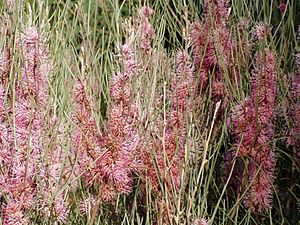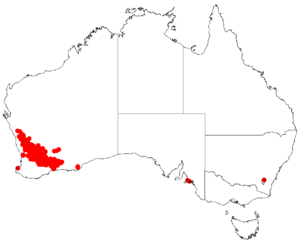Hakea scoparia facts for kids
Quick facts for kids Hakea scoparia |
|
|---|---|
 |
|
| Scientific classification | |
| Genus: |
Hakea
|
| Species: |
scoparia
|
 |
|
| Occurrence data from Australasian Virtual Herbarium | |
Hakea scoparia is a unique flowering plant that belongs to the Proteaceae family. It grows only in the south-west part of Western Australia. This plant is a type of shrub that has branches reaching upwards. It's known for its long, needle-like leaves and pretty clusters of cream to pinkish flowers. These flowers usually bloom between June and September.
Contents
What Does Hakea scoparia Look Like?
Hakea scoparia is a round, bushy shrub with many stems. It can grow to be about 1 to 3.5 meters (3 to 11 feet) tall. This plant has smooth bark and its branches grow upwards.
Flowers and Leaves
The plant produces beautiful clusters of 50 to 70 pinkish-cream colored flowers. These flowers grow where the leaves meet the stem. Each flower has a smooth stalk and a cream-colored outer part (called the perianth) that turns pink or orange-pink as it gets older. The part of the flower that contains the seeds (the pistil) is about 13 to 15 millimeters long.
The young branches are often covered with soft, matted hairs or silky hairs when the plant is flowering. Sometimes, they can be smooth without hairs. The leaves are long and thin, like needles, measuring about 12 to 27 centimeters (5 to 11 inches) long and 1.5 to 2 millimeters wide. They grow in an alternating pattern and have five lines running along their length.
Fruit and Seeds
After flowering, Hakea scoparia produces interesting seed capsules. These fruits are rough and three-dimensional, about 2 centimeters (0.8 inches) long and 1 centimeter (0.4 inches) wide. Each fruit ends in a short, noticeable beak. The fruits usually grow in groups of 1 to 8 on a short stalk where the leaves meet the stem.
How Hakea scoparia Got Its Name
Hakea scoparia was first officially described in 1845 by a Swiss botanist named Carl Meissner. He wrote about it in a book called Plantae Preissianae. His description was based on plants collected near the Swan River by another botanist, James Drummond.
The second part of its name, scoparia, comes from the Latin word scopa. This word means "broom." It was chosen because the plant's leaves look a bit like the bristles of a broom.
Where Hakea scoparia Grows
Hakea scoparia is a common plant found mostly across the wheatbelt region of Western Australia. You can find it from south of Northampton to Dumbleyung, and stretching east to Yilgarn.
Habitat and Environment
This plant likes to grow in areas with heath and scrubland. It can be found in yellow sand over laterite (a type of soil), gravel, sandy-clay, and loam. It's a tough plant that can handle frost, and it prefers to grow in sunny spots.
Conservation Status
The Western Australian Government's Department of Parks and Wildlife has classified Hakea scoparia as "not threatened." This means that the plant is not currently at risk of disappearing.

